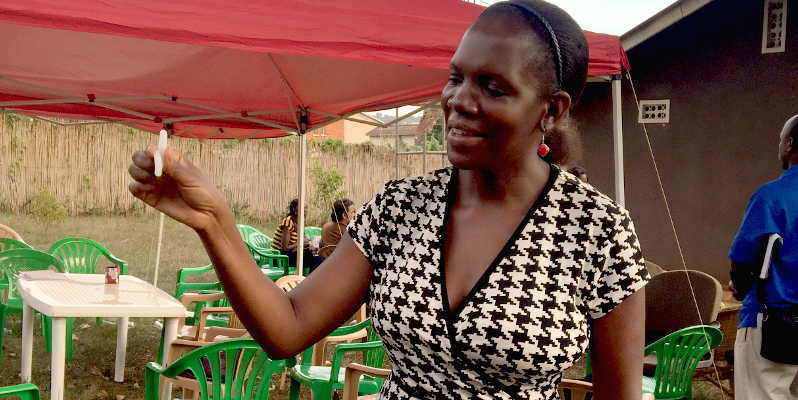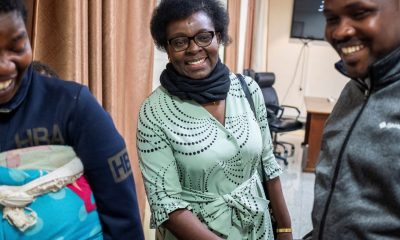Health
Women give the virginal ring against HIV a thumbs up

Dr. Flavia Matovu of Makerere University Johns Hopkins University showing how the virginal ring is folded before its inserted
Findings of two new studies on the use of a virginal ring to prevent women from contracting the deadly HIV Virus have attracted optimism among women folk in Uganda who describe it as an easy to use, safe and empowering tool in the fight against the disease.
Carried out in four African countries; Uganda, Zimbabwe and Malawi, the studies examined whether a ring containing an antiretroviral drug and inserted into a woman’s virgina, can protect her from contracting the HIV virus.
Researchers from Makerere University Johns Hopkins University (MUJHU) who carried out the study in Uganda told journalists that they found that in one of the studies, the ring was effective in protecting 27 percent of the women, while in another the level of protection increased to as high as 31 percent. 4500 women participated in the two studies.
Allen Kakiiza, one of the participants in the study said she loved the ring because besides giving her protection, she was comfortable with it and yet her partner never got to know that she had it.
Kakiiza also described the ring as an empowering tool for women who until now relied on male-controlled HIV preventive methods such as the commonly-used condom.
Dr. Flavia Matovu Kiweewa who was the lead researcher in one of the studies said the findings proved that the ring is an effective, safe, easy to use and discrete women-controlled HIV-preventive method.
“This is very exciting because we believe that for the first time, women have a safer and more effective tool to protect themselves against contracting HIV,” said Matovu.
Dr. Matovu pleaded with the Ugandan government to put in place enabling regulations and policies that can allow every woman in Uganda to be able to access the ring after the study has gone through an audit by the American Food and Drug Administration (FDA).
She pointed out that the ring is a safer option compared to the oral method of using anti-retroviral drugs in what is commonly known as Pre-exposure prophylaxis (PrEP) because of the associated side effects such as liver and bone damage that come with accumulation of the drug in a person’s body.
The ring is manufactured by the International Partnership for Microbicides while the study was sponsored by the United States National Institute of Health.
Matovu was cautious to note however that an off-the-counter product for purchase by ordinary customers is not expected until 2017-2018 because of pending regulatory procedures.
The researchers pointed out however that among young women aged 18-21 years, the ring did not have a impact in as far as reducing new infections is concerned.
The researchers attributed the disappointing results among to young women to poor adherence in the use of the ring, compared to older counterparts aged 21 and above who registered protection of up to 60 percent.
In the meantime, the researchers say that all the women who participated in the trial will be availed with an active ring.
And according to Angelo Kaggwa-Katumba, the Programme Manager of the New York based AVAC – the Global Advocacy for HIV Prevention, previous studies have shown that when people are sure that they have the effective drug rather than a control, the percentage of protection tends to go up.
Lillian Mworeko, the Executive Director of the International Community of Women Living with HIV – Eastern Africa (ICWEA) called on the government of Uganda to put in place guidelines that can enable women get access not only to the ring but also to PrEP which is licensed for use in countries such as Kenya and South Africa.
But Rachel Nandelenga, who works with ICWEA observed that for such methods to be able to have an impact, Uganda needs to tackle the root causes of rising new infections. She pointed out that currently, 60 percent of all new HIV infections happen among young women, who are victims of early marriages, gender-based violence, inability to negotiate for safer sex.
Comments


















